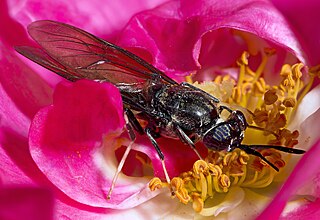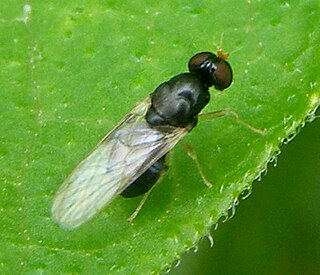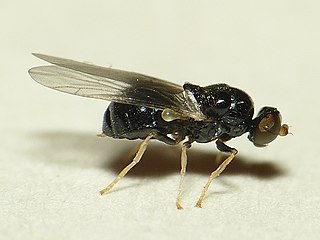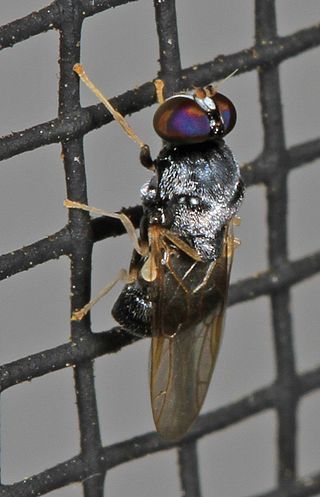
The soldier flies are a family of flies. The family contains over 2,700 species in over 380 extant genera worldwide. Larvae are found in a wide array of locations, mostly in wetlands, damp places in soil, sod, under bark, in animal excrement, and in decaying organic matter. Adults are found near larval habitats. They are diverse in size and shape, though they commonly are partly or wholly metallic green, or somewhat wasplike mimics, marked with black and yellow or green and sometimes metallic. They are often rather inactive flies which typically rest with their wings placed one above the other over the abdomen.

Hermetia illucens, the black soldier fly, is a common and widespread fly of the family Stratiomyidae. Since the late 20th century, H. illucens has increasingly been gaining attention because of its usefulness for recycling organic waste and generating animal feed.

Zabrachia is a genus of soldier flies in the family Stratiomyidae. Adults can be distinguished from other Pachygastrinae by the fused R4 and R5 wing veins. Females have been collected during oviposition into pine wood, and larvae are known to live under the bark of coniferous trees, including lodgepole pine, ponderosa pine, and Douglas fir.

Pachygaster leachii, the yellow-legged black, is a European species of soldier fly.

Pachygaster is a genus of flies in the family Stratiomyidae.

Pachygaster atra, the dark-winged black, is a European species of soldier fly.

Neopachygaster meromelaena, the silver-strips black, is a European species of soldier fly.

Neopachygaster is a genus of flies in the family Stratiomyidae.
Berkshiria albistylum is a species of soldier fly in the family Stratiomyidae. Larvae can be found under the bark of poplar trees.
Pachygaster montana is a species of soldier fly in the family Stratiomyidae.

Allognosta fuscitarsis is a species of soldier fly in the family Stratiomyidae.

Gowdeyana punctifera is a species of soldier fly in the family Stratiomyidae. The range of this species includes the Canadian provinces of British Columbia, Saskatchewan, Ontario, and Quebec.
Cosmariomyia pallidipennis is a species of soldier fly in the family Stratiomyidae.
Neopachygaster caucasica is a species of soldier fly in the family Stratiomyidae.
Pachygaster characta is a species of soldier fly in the family Stratiomyidae.
Pachygaster dorsalis is a species of soldier fly in the family Stratiomyidae.
Pachygaster flavimanus is a species of soldier fly in the family Stratiomyidae.
Pachygaster annulipes is a species of soldier fly in the family Stratiomyidae. The distribution is within India.
Pachygaster flavipennis is a species of soldier fly in the family Stratiomyidae.
Pachygaster subatra is a species of soldier fly in the family Stratiomyidae.







